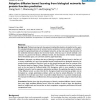680 search results - page 86 / 136 » Genomic computing: explanatory modelling for functional geno... |
BMCBI
2006
13 years 8 months ago
2006
Background: Methods for predicting protein function directly from amino acid sequences are useful tools in the study of uncharacterised protein families and in comparative genomic...
BMCBI
2008
13 years 8 months ago
2008
Background: Machine-learning tools have gained considerable attention during the last few years for analyzing biological networks for protein function prediction. Kernel methods a...
BMCBI
2007
13 years 8 months ago
2007
Background: Incorrectly annotated sequence data are becoming more commonplace as databases increasingly rely on automated techniques for annotation. Hence, there is an urgent need...
BMCBI
2005
13 years 8 months ago
2005
Background: Alternative splicing is a major mechanism of generating protein diversity in higher eukaryotes. Although at least half, and probably more, of mammalian genes are alter...
BMCBI
2006
13 years 8 months ago
2006
Background: In order to improve gene prediction, extrinsic evidence on the gene structure can be collected from various sources of information such as genome-genome comparisons an...


